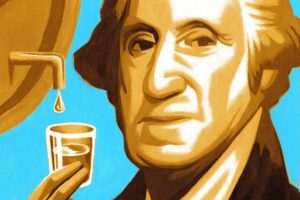Historically Speaking: Whiskey Is the Original ‘Cup of Kindness’
The barley fields of Scotland and Ireland gave birth to a drink that became popular around the world
The Wall Street Journal, December 27, 2019
On New Year’s Eve, the song “Auld Lang Syne” urges us to “take a cup of kindness.” It’s an old Scottish saying, meaning to share a friendly tipple—presumably of single malt whiskey.
Nowadays there are whisky (Scottish, with no e), whiskey (Irish and North American), rye whiskey (North American) and bourbon (American), but no matter what the drink is called, the method for making it is essentially the same. Like beer, its ancient precursor, whiskey is made with water, grains and yeast. It’s the distillation process that leads to a higher alcohol content in whiskey. For that we must thank an Egyptian alchemist from around the 2nd century named Maria Hebraea (Mary the Jewess) of Alexandria, whose celebrated inventions include the distillation pot.

ILLUSTRATION: THOMAS FUCHS
In the boggy moors of Scotland and Ireland, where never a grape will grow but barley is plentiful, medieval monks learned how to make a whiskey fiery enough to take a man down if he wasn’t careful. The Annals of Clonmacnoise, a 15th-century chronicle of early Irish history, records that in 1405 the clan chieftain Richard MaGranell drank a “surfeit” of whiskey over Christmas and died.
From the 17th century onward, Scotch-Irish emigrants to the New World brought their distillation techniques with them. But it was an Englishman, the Jamestown colonist George Thorpe, who learned that whiskey could be made just as easily with Indian corn. Thorpe was killed in the 1622 Powhatan massacre, but his inventiveness helped to create the American love affair with bourbon, which is made from corn and aged in charred new oak barrels.
Back in the mother country, the punitive Malt Tax of 1725 drove the British whiskey industry underground. Scottish distilleries became secretive nighttime operations, which is how the nickname “moonshine” came to be. A similar whiskey tax levied by the U.S. government in 1791, to pay down the country’s Revolutionary War debt, met with fierce resistance, sparking the so-called Whiskey Rebellion among Pennsylvania farmers. Whiskey production was a lucrative business, so much so that in retirement George Washington turned his Mount Vernon plantation into the country’s largest distillery.
British visitors to the U.S. during the 19th century were delighted by the myriad ways that bourbon could be enjoyed. In 1842, Charles Dickens passed a night in Baltimore drinking mint juleps with Washington Irving; it was, he wrote, “among the most memorable of my life.” American tourists were equally impressed with British know-how around a single malt. In 1874, Mark Twain wrote to his wife Olivia, “Ever since I have been in London I have taken in a wine glass what is called a cock-tail.” The ingredients consisted of “a bottle of scotch whisky, a lemon, some crushed sugar, and a bottle of Angostura bitters.”
Whiskey’s reputation as the liquor of choice for Prohibition Era bootleggers and tortured geniuses like the novelist William Faulkner made it deeply unfashionable among the vodka-drinking MTV generation. But there’s a revival under way, aided by millennials’ love of cocktail culture. In October, a bottle of 1926 Macallan single malt whisky smashed all auction records for a wine or spirit, selling for $1.9 million. That’s $76,000 per ounce of kindness, my dear, or $158,333 a cocktail.
